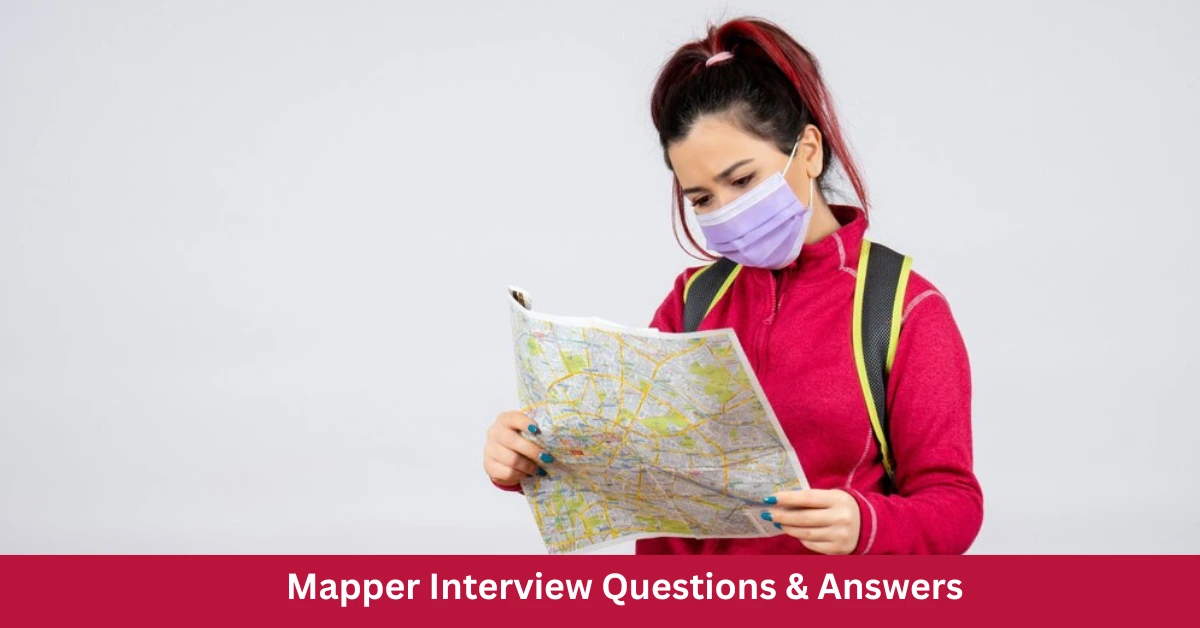A Mapper plays a crucial role in converting geographic, spatial, or environmental data into accurate, actionable maps. This role is vital in sectors like urban planning, navigation, natural resource management, and logistics. Whether you’re an aspiring Mapper or looking to improve your interview skills, these top 15 Mapper interview questions and answers will guide you in showcasing your expertise.
15 Mapper Interview Questions & Answers
Here’s a comprehensive list of 15 Mapper interview questions and answers along with detailed answers to help you prepare and impress your interviewers.
1. What is the role of a Mapper?
Answer:
A Mapper is responsible for converting raw spatial or geographic data into meaningful, visual representations, such as maps. They use GIS (Geographic Information Systems) software to create maps for various purposes, such as navigation, urban planning, and resource management.
2. What software or tools do you use for mapping?
Answer:
I have experience using the following tools:
- GIS software: ArcGIS, QGIS
- Mapping platforms: Google Maps API, Mapbox
- Remote sensing tools: ERDAS IMAGINE, ENVI
- Data visualization tools: Tableau, Power BI
3. How do you ensure data accuracy in the maps you create?
Answer:
Accuracy is maintained by:
- Validating source data with GPS or other reliable sources.
- Using satellite imagery and field verification to cross-check data.
- Performing accuracy tests and quality control before finalizing the map.
Related Article: Top 15 Cadastral Mapper Interview Questions
4. What is the difference between vector and raster data in mapping?
Answer:
- Vector data uses points, lines, and polygons to represent geographic features (e.g., roads, buildings).
- Raster data consists of grid cells (pixels), often used for continuous data like elevation or temperature.
5. What are map projections, and why are they important?
Answer:
Map projections are methods for translating the Earth’s 3D surface onto a 2D plane. They are essential because different projections can distort area, shape, or distance, and the choice of projection depends on the map’s purpose. Common projections include Mercator, Lambert Conformal Conic, and Robinson.
Related Article: Top 17 Cartographer Interview Questions
6. How do you deal with missing or incomplete data when creating maps?
Answer:
I handle missing or incomplete data by:
- Using interpolation techniques to estimate missing values.
- Cross-referencing with other data sources to fill gaps.
- Indicating areas of uncertainty or missing data on the final map.
7. What is georeferencing, and why is it important?
Answer:
Georeferencing is the process of aligning spatial data with a coordinate system. It’s critical because it ensures that map features are accurately placed on the Earth’s surface, allowing for correct spatial analysis and integration with other datasets.
Related Article: 15 Cartographic Designer Interview Questions
8. What are some challenges you face when creating maps, and how do you overcome them?
Answer:
Challenges include inaccurate data, discrepancies between different datasets, and technical limitations of mapping tools. I overcome these by:
- Ensuring data comes from reliable sources.
- Using data validation and preprocessing techniques.
- Exploring alternative tools or methods when needed.
9. How do you determine the scale of a map?
Answer:
The scale of a map is determined by the level of detail needed and the geographic area covered. Larger scales (e.g., 1:10,000) show more detail in a smaller area, while smaller scales (e.g., 1:1,000,000) cover broader regions with less detail.
10. How do you integrate different types of data into a single map?
Answer:
I integrate different data types by:
- Ensuring they share a common coordinate system.
- Using GIS tools to merge datasets based on attributes.
- Validating data consistency and accuracy across sources.
Related Article: Top 15 LIDAR Technician Interview Questions & Answers
11. What is metadata, and why is it important in mapping?
Answer:
Metadata provides essential information about the source, accuracy, and methods used in data collection. It ensures transparency, helping others understand the map’s reliability and limitations.
12. How do you maintain the visual appeal and readability of your maps?
Answer:
To ensure maps are visually appealing and readable, I:
- Use clear labels, symbols, and colors that are easy to distinguish.
- Maintain a consistent layout with appropriate legends and scale bars.
- Avoid cluttering the map with too much detail, ensuring it remains focused on its purpose.
Related Article: 15 Cartographic Drafter Interview Questions and Answers
13. What role do maps play in decision-making, and how do you ensure they’re effective?
Answer:
Maps play a vital role in decision-making by providing spatial context. I ensure maps are effective by:
- Tailoring the map design to the decision-making process (e.g., focusing on key features).
- Ensuring data accuracy and clarity.
- Presenting the map in a format that is easily interpretable by the target audience.
14. How do you stay current with mapping technologies and trends?
Answer:
I stay updated by:
- Participating in online forums and webinars focused on GIS and mapping.
- Taking online courses to learn about new tools and techniques.
- Following industry blogs and reading publications on mapping and geospatial technologies.
Related Article: Top 15 Cartography Technician Interview Questions and Answers
15. Can you describe a successful mapping project you’ve worked on?
Answer:
I worked on a project mapping transportation infrastructure for a city. By integrating traffic data, road conditions, and GPS data, the map helped optimize traffic flow and prioritize road repairs. The project was well-received by local authorities and improved urban planning decisions.
Conclusion
Mappers play an essential role in translating spatial data into visual representations that help decision-makers in various industries. These top 15 Mapper interview questions and answers will help you prepare for your next interview by showcasing your skills in GIS tools, data integration, and map design.
Stay tuned to our blog for more resources and tips to enhance your career in geospatial technology!
